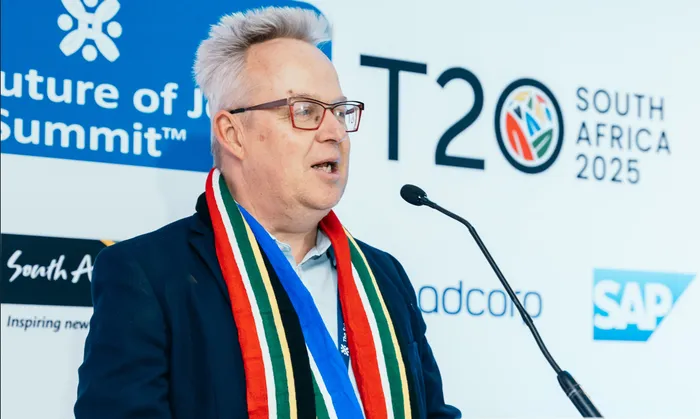Steenkampskraal: South Africa’s hidden billion-rand opportunity

Dr Nik Eberl is the Founder & Executive Chair: The Future of Jobs Summit™ (Official T20 Side Event) .He will be writing a regular column in Business Report.
Image: Supplied
An abandoned mine. A global superpower desperate for supply. And South Africa quietly holding the solution. This isn’t fiction — it’s happening right now in Steenkampskraal, a forgotten town in the Western Cape.
For six decades the site gathered dust. Anglo American walked away in 1963, convinced it was exhausted. They were wrong — by about R50 billion. Today, Steenkampskraal’s rare-earth deposits could reshape global supply chains, challenge China’s dominance, and position South Africa as a critical player in the electric-vehicle, renewable-energy and defence industries.
The Rare-Earth Revolution
The world has entered a new resource war — not for oil or gold, but for elements most people can’t pronounce: neodymium, praseodymium, dysprosium and terbium. These minerals are the invisible engine of modern life. Every EV motor, wind turbine and military drone depends on them.
Yet one country — China — controls 92 percent of global processing. That concentration of power has turned supply chains into strategic vulnerabilities. Any disruption in Beijing reverberates through Detroit, Berlin and Silicon Valley. For years, the world accepted this imbalance as inevitable. Until now.
Steenkampskraal is among the highest-grade rare-earth deposits on the planet — roughly 20 percent ore grade, compared with an industry average of 2 percent. In mining terms, that is the equivalent of finding a gold mine made of gold. South Africa, long seen as a supplier of traditional commodities, suddenly finds itself holding the keys to the technologies of the future.
Seeing value where others don’t
Having advised leaders across five continents, I’ve learned that the greatest opportunities — whether in resources or in people — are often overlooked. Steenkampskraal is a case study in perception. What one company deemed worthless in 1963 is now a potential cornerstone of global decarbonisation.
The same blindness occurs inside organisations every day. Companies quietly walk away from their own “depleted” assets: experienced employees, outdated systems, unglamorous divisions. Then a competitor comes along, sees what they missed, and builds an empire on it.
The parallels are striking. That engineer who keeps questioning the status quo could be your next innovation catalyst. The “old-school” manager insisting on human contact might be the cultural glue holding the team together. The sales rep who struggles with quotas might flourish in customer experience.
While many firms chase the same polished résumés and AI-friendly keywords, true competitive advantage lies in recognising and activating the potential that others can’t or won’t see.
The Billion-Rand Principle
The Industrial Development Corporation’s investment to revive Steenkampskraal, which in time could be valued in the billions, is more than a mining story; it is a masterclass in strategic foresight. The IDC is betting on a principle every business should understand: value doesn’t vanish — it merely waits for someone with new eyes to see it”
Corporate South Africa faces its own Steenkampskraals. In an era of skills shortages, brain drain and digital disruption, the temptation is to look outward — to hire, import or automate our way to competitiveness. But sustainable growth will come from looking inward: re-evaluating the people, partnerships and capabilities we already possess.
A company’s balance sheet lists assets; its future depends on how it treats the ones it can’t easily measure.
From Rare Earth to Human Capital
Unlocking hidden value is not an HR exercise; it’s a leadership discipline. Like rare-earth minerals, human potential must be mined, refined and applied with intent. That means mentorship instead of micromanagement, coaching instead of compliance, and environments that reward curiosity rather than conformity.
Consider how nations build resilience. They diversify supply, invest in processing capacity, and form strategic partnerships. Businesses can do the same with talent: cultivate multiple sources of innovation, invest in capability development, and build cross-functional teams that blend experience with experimentation.
The payoff is immense. Organisations that learn to recognise hidden potential don’t just save costs; they generate entirely new value streams. They innovate faster, adapt quicker and inspire deeper loyalty.
A National Opportunity hiding in plain sight
Steenkampskraal is more than a mining revival; it is a metaphor for South Africa’s economic renewal. Our country is rich in both minerals and minds. The question is whether we have the strategic imagination to harness them.
If South Africa can move beyond extraction to beneficiation — processing and manufacturing the magnets, batteries and components that rare earths enable — the impact on jobs, exports and national confidence could be transformative. Similarly, if our companies can look beyond job titles and rediscover the potential in their people, we can build organisations that compete not just on price but on purpose and ingenuity. Both challenges require the same mindset: seeing value where others see decline.
The Leadership Question
So ask yourself: what is your Steenkampskraal? What dormant resource, project or person inside your organisation could hold extraordinary value if viewed differently? What assumptions — about markets, talent or technology — need to be revisited before someone else proves them wrong?
Leadership, like geology, is the art of discovery. It demands patience, perspective and the courage to dig deeper than the surface data suggests.
Steenkampskraal reminds us that yesterday’s failures can become tomorrow’s fortunes. Whether we are talking about a mine, a business unit or a team member, the principle is timeless: the future belongs to those who can see potential before it becomes obvious. Your Steenkampskraal is waiting. Are you ready to see it?
Dr Nik Eberl is the founder and executive chair: The Future of Jobs Summit™ (Official T20 Side Event). He is also author: Nation of Champions: How South Africa won the World Cup of Destination Branding.
*** The views expressed here do not necessarily represent those of Independent Media or IOL.
BUSINESS REPORT